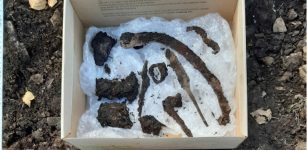Ancient Round Coins Were Invented To Prevent Fraud
AncientPages.com - Have you ever wondered why coins are round? The answer can be found in historical records. There is a valid reason why our ancestors decided to produce round coins. It was the best way to prevent fraud.
Most ancient coins were round, but far from all. Ancient Chinese coins for example came in different shapes, and in Japan people used rectangular coins as well as round coins with a hole in the middle.
When and where the first coins were invented is still a matter of debate, but the first coins used as a method of payment appeared around the 6th or 5th century B.C.
Main coins of Tokugawa coinage. A large ovoid gold Koban, under it a small gold Ichibuban, top right a silver Ichibuban, under it a silver Isshuban and a bronze round "Kan'ei tsuho" Mon. Credit: Wikipedia
According to Greek historian Herotodus, first payment coins were produced in Lydia, an Iron Age kingdom in modern western Turkey. Aristotle on the other hand claimed that the first coins were minted by Demodike of Kyrme, the wife of King Midas of Phrygia.
What historians do know is that Lydians made their coins from a naturally occurring mixture of gold and silver called electrum. Lydian coins were oval-shaped and had a design on one side only. The other side was marked with simple punches.
See also:
Beer Was Used As Medicine And Payment In Ancient Egypt
Roman Consuls Seized Power Through Intimidation, Bribery And Show Business
Modern Banking Concept Started In Ancient Babylonian Temples
Ancient Greeks adopted the Lydians’ method and improved it by manufacturing coins that were almost completely round coins. This technology spread throughout the ancient world.
Ancient Romans quickly discovered all benefits of round coins. For one thing, such coins could be used as an efficient propaganda tool. People who lived in the outskirts of Rome were not always well-informed about political changed in the Roman Empire.
The most commonly used coin denominations and their relative sizes during Roman times. Credit: Wikipedia
When coins appeared with the new Emperor's portrait, people new the previous ruler had been replaced.
Round coins were also practical because their corners could not be removed. Cutting off precious metal and trying to trade the coin’s value was very difficult.
If an dishonest money handler was tempted to snip off a bit from the edge of each coin, rendering it less valuable, he would have problems. A round coin would reveal that sort of tampering better than any other shape, since it would have a flat edge where it was snipped.
So, producing round coins was a way of preventing fraud. If you are interested in the long history of money, Ancient Pages published a comprehensive article on the subject: Our Lives Have Always Been Manipulated By Money – Part 1 – 3
In the above mentioned article, we go back 4500 years in time and find that silver rods were the world’s first money. They were introduced in Mesopotamia. It was believed they would smooth the progress of trade.
Copyright © AncientPages.com All rights reserved. This material may not be published, broadcast, rewritten or redistributed in whole or part without the express written permission of AncientPages.com
More From Ancient Pages
-
 Image Of The Day: The Inghirami Tomb At Volterra, Italy
Image Of The Day | Sep 9, 2015
Image Of The Day: The Inghirami Tomb At Volterra, Italy
Image Of The Day | Sep 9, 2015 -
 Magnificent Trumpington Cross And Highly Unusual Anglo-Saxon ‘Bed Burial’ In Cambridge Offer Unique Insight Into English Christianity
Archaeology | Feb 22, 2018
Magnificent Trumpington Cross And Highly Unusual Anglo-Saxon ‘Bed Burial’ In Cambridge Offer Unique Insight Into English Christianity
Archaeology | Feb 22, 2018 -
 Undeciphered Ancient Symbols On Boulders In Pennsylvania And New England Could Be An Ancient Diary Of Forgotten Civilizations And Events
Featured Stories | Jul 4, 2024
Undeciphered Ancient Symbols On Boulders In Pennsylvania And New England Could Be An Ancient Diary Of Forgotten Civilizations And Events
Featured Stories | Jul 4, 2024 -
 North America Is Named After An Italian Explorer
Ancient History Facts | Mar 1, 2016
North America Is Named After An Italian Explorer
Ancient History Facts | Mar 1, 2016 -
 Surprising Discovery Of Box Filled With Neanderthal Bones From Cova Simanya Donated To Museum
Archaeology | Sep 21, 2023
Surprising Discovery Of Box Filled With Neanderthal Bones From Cova Simanya Donated To Museum
Archaeology | Sep 21, 2023 -
 Famed Makishi Dancers And Likumbi Lya Mize Ceremony In Zambia – Much More Than Just A Festival
Ancient Traditions And Customs | Aug 6, 2019
Famed Makishi Dancers And Likumbi Lya Mize Ceremony In Zambia – Much More Than Just A Festival
Ancient Traditions And Customs | Aug 6, 2019 -
 2,000 Years Ago Mysterious Foreigner With Unique Ancestry Traveled To Cambridgeshire – Who Was He?
Archaeology | Dec 27, 2023
2,000 Years Ago Mysterious Foreigner With Unique Ancestry Traveled To Cambridgeshire – Who Was He?
Archaeology | Dec 27, 2023 -
 Statue Of Apollo Discovered in Ancient City Of Prusias ad Hypium, Turkey
Archaeology | Aug 26, 2022
Statue Of Apollo Discovered in Ancient City Of Prusias ad Hypium, Turkey
Archaeology | Aug 26, 2022 -
 Glima – Ancient Martial Art Practiced By The Vikings Is Still Popular Today
Ancient Traditions And Customs | Mar 7, 2017
Glima – Ancient Martial Art Practiced By The Vikings Is Still Popular Today
Ancient Traditions And Customs | Mar 7, 2017 -
 How Extensively Did Early Farmers Utilize Europe’s Rich Forests For Raising Their Livestock?
Archaeology | Nov 13, 2024
How Extensively Did Early Farmers Utilize Europe’s Rich Forests For Raising Their Livestock?
Archaeology | Nov 13, 2024 -
 Odd Ancient Dwellings Of The Snake People – American-European Connection Part 1
Featured Stories | Sep 6, 2020
Odd Ancient Dwellings Of The Snake People – American-European Connection Part 1
Featured Stories | Sep 6, 2020 -
 Jersey’s Ancient Faldouet Dolmen Vandalized To Extract Quartz Crystals
News | Nov 10, 2020
Jersey’s Ancient Faldouet Dolmen Vandalized To Extract Quartz Crystals
News | Nov 10, 2020 -
 Viking Grave Discovered In The Middle Of Oslo, Norway
Archaeology | Dec 23, 2022
Viking Grave Discovered In The Middle Of Oslo, Norway
Archaeology | Dec 23, 2022 -
 Puzzling McClelland Sherd – Undeciphered Inscription Could Be Early Bronze Age Writing
Artifacts | Mar 27, 2018
Puzzling McClelland Sherd – Undeciphered Inscription Could Be Early Bronze Age Writing
Artifacts | Mar 27, 2018 -
 Hadrian’s Wall: North-West Frontier Of The Roman Empire For Nearly 300 Years
Featured Stories | Sep 1, 2020
Hadrian’s Wall: North-West Frontier Of The Roman Empire For Nearly 300 Years
Featured Stories | Sep 1, 2020 -
 More Than 2,500 Years Old Gallic Tombs Unearthed In Nîmes, Southern France
Archaeology | Aug 17, 2020
More Than 2,500 Years Old Gallic Tombs Unearthed In Nîmes, Southern France
Archaeology | Aug 17, 2020 -
 Mythical Stymphalian Birds: Terrible Winged Maidens With Birds’ Feet
Featured Stories | Feb 27, 2017
Mythical Stymphalian Birds: Terrible Winged Maidens With Birds’ Feet
Featured Stories | Feb 27, 2017 -
 Impressive Study Highlights Female-Led Migration Into Bronze Age Orkney And Wins Prestigious Award For 2023
Archaeology | Apr 4, 2023
Impressive Study Highlights Female-Led Migration Into Bronze Age Orkney And Wins Prestigious Award For 2023
Archaeology | Apr 4, 2023 -
 Researchers Confirm Clovis People Used Great Lakes Camp Annually About 13,000 Years Ago
Archaeology | Sep 12, 2024
Researchers Confirm Clovis People Used Great Lakes Camp Annually About 13,000 Years Ago
Archaeology | Sep 12, 2024 -
 Ancient Superhighways: 12,000-Year-Old Massive Underground Tunnels From Scotland To Turkey
Featured Stories | Jul 19, 2015
Ancient Superhighways: 12,000-Year-Old Massive Underground Tunnels From Scotland To Turkey
Featured Stories | Jul 19, 2015



